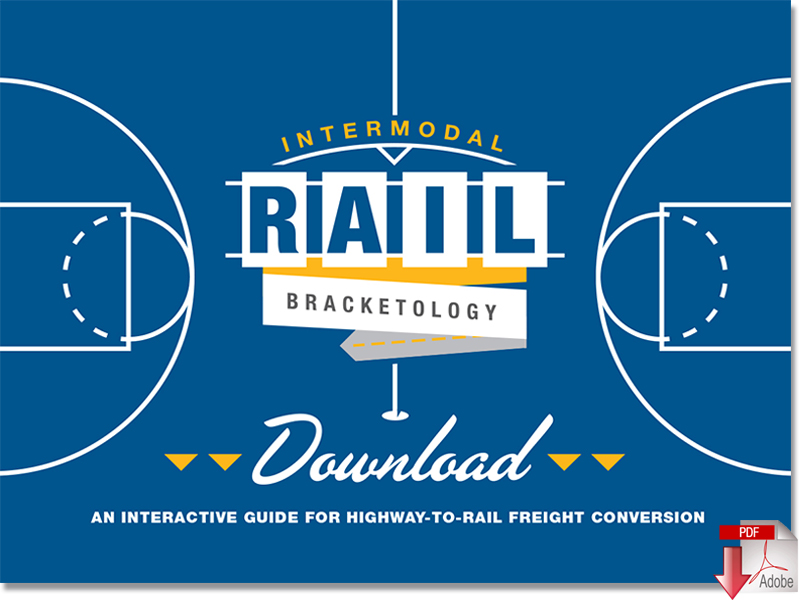Comparing Past March Madness Upsets to Supply Chain Disruptions

What can logistics professionals learn from past March Madness upsets to protect their supply chains from future disruptions?
Anything can happen during March Madness: an unbeatable coach loses with a last second buzzer-beater, a Cinderella team rises from the ashes, a powerhouse team falls apart.
These types of monumental upsets happen each spring, though they certainly are not contained to the hardcourt.
Supply chain professionals compete with upsets in the form of supply chain disruptions such as inclement weather, labor disputes, capacity crunches and rising costs, not just every spring, but every day, month and year.
They know that disruptions and upsets are inevitable and know no season, geography or period in time.
Find out what the greatest March Madness upsets of all time can teach you about your supply chain.
The coach is key, but even a great coach can experience an upset
In 1973, UCLA, coached by the legendary John Wooden, won the national title 87-66 over Memphis State. This gave UCLA their 7th consecutive title and cemented their status as one of the greatest college basketball dynasties of all time. However, in 1974 the NC State Wolfpack put an end to this incredible streak by taking down UCLA 80-77 in the Final Four.
Just as the Wolfpack disrupted Wooden and UCLA’s winning streak, supply chain disruptions can (and do) throw seasoned supply chain leaders off their games.
For instance, in that same year beginning in October of 1973, Arab members of the Organization of Petroleum Exporting Countries (OPEC) started an oil embargo. The embargo would not end until March of 1974 raising the price of gas from $3 a barrel to $12. Supply chain leaders were faced with soaring fuel prices and had to adapt quickly in order to find more efficient forms of transportation.
Shippers began evaluating the cost and environmental impacts of freight transportation and demand for smaller, more fuel-efficient vehicles increased. This kickstarted U.S. interest in sustainability and alternative fuels as the public and shippers realized they had to find more fuel-efficient solutions in order to stay ahead of volatile fuel prices.
As the coach of your supply chain, whether you are a seasoned veteran like Coach Wooden or new in your role, how you handle disruptions is critical. In today’s world, many organizations don’t have, or plan to have, a Chief Supply Chain Officer, which means that all transportation leaders across the supply chain - from the supply chain analyst to the director of procurement - must prepare and plan for disruptions.
2. It’s Not Over Till the Clock Hits 00:00

Things can change in an instant and every second counts
The 1981 NCAA Tournament featured not just one but three tournament favorites being upset in the last moments of each game. All three upsets happened in the second round with 9-seed St. Joseph’s 49-48 victory against 1-seed DePaul, 5-seed Arkansas’ 74-73 win against 4-seed Louisville and 8-seed Kansas State’s 50-48 come-from-behind win against 1-seed Oregon State.
Successful supply chain managers also know every second counts and things can shift in an instant.
At the beginning of 2007, Steve Jobs, who only a few years earlier was thought of as finished and irrelevant in the technology space, came bounding back into the game with the official release of the iPhone. Jobs kickstarted the mobile technology revolution and established himself as the father of innovation. This caused a major shift to take place almost overnight that totally changed the way we live, do business and even move freight.
The iPhone democratized data and computing, forever changing how we communicate and purchase goods. It leveled the playing field, allowing organizations of all sizes and functions to become data-driven, and ushered in new technologies to streamline the supply chain.
Some of these emerging technologies in the transportation space include GPS and tracking systems that make it easier for truck drivers to navigate deliveries, as well as Transportation Management Systems (TMS) that help supply chain managers optimize their transportation moves.
In logistics, how things are done can change quickly out of necessity or invention. Having a strong contingency plan in place, along with the right technology tools, can help head off potential upsets.
You should never discount the underdog
Coming into the 1999 NCAA tournament, the UCONN Huskies were written off as ill-prepared to have any shot at winning. The Huskies had been a great team for the past decade but had never even made a Final Four appearance. In 1999 the Huskies not only reach the Final Four but managed to upset 1-seed Duke to win their first NCAA Basketball National Championship.
Just as anything can happen in March Madness, anything can happen in logistics. Supply chain managers should always plan for the unexpected and never write off an underdog.
Before 1999, the internet was an exciting, if unknown, medium. Investors, not wanting to miss out on the next big thing, quickly and heavily over valued and invested in a multitude of emerging Internet-based companies. If “.com” was in the title, they were expected to succeed and stock prices soared. However, from 1999-2001 this massive overvaluation ended, and the bubble burst. Many companies went out of business or lost market share they could never recover. However, a few select companies, such as Amazon, weathered the storm and ultimately found great success.
The Huskies continuously improved their game so they were ready to overcome the odds, and so too did the companies who successfully weathered the dot-com bubble. Rather than fading into irrelevance, the dot-com crash laid the groundwork for the omni-channel consumer. This had lasting impacts on the supply chain as buyers now want more selection, faster delivery and the ability to seamlessly shift from shopping in brick and mortar storefronts to shopping in virtual storefronts via their mobile phones.
The dot-com bubble is an excellent reminder to not get caught up in the short term, but to focus on long-term planning and diversification to succeed through any disruption.
4. Taking a Strategic Chance Can Pay Off in the Long-Run

Any team can win if they know when to pass and when to shoot
Perhaps one of the greatest games in NCAA history is an upset that never happened. On March 17, 1989, in the opening round of the NCAA men’s basketball tournament, 16-seed Princeton faced off against 1-seed Georgetown University. With a 50-49 loss for Princeton, this is the closest a 16-seed has ever come to upsetting a 1-seed. This game helped establish the tournament’s “upset” reputation based on the idea that any team can win it all.
The successful ratings of this small “almost upset” game convinced CBS executives of the opportunity and value of airing the first round games, resulting in the station taking a chance and signing a seven-year, $1 billion deal to begin airing the entire tournament.
Supply chain managers must also learn to look for opportunities, big, small and even “out there,” and be prepared to take advantage of them when they are presented.
The concept of intermodal rail was founded by forward-thinking entrepreneurial business people who decided to take a long shot in order to realize efficiencies. PT Barnum’s piggybacked circus train and Malcom Mclean’s containerization concept gave shippers the ability to blend ship, truck and train together to form one fluid and efficient freight channel. This use of intermodal, or “multi-modal” shipping had a major global economic impact. It helped create a new Silk Road by opening up markets and accelerating the possibilities associated with global, transcontinental and domestic trade.
These men turned a small insight, utilizing multiple modes of transportation, into a major transportation revolution that had global impact for U.S. and international shippers.
In the NCAA tournament, players often only get a second to make a game winning shot. In logistics, supply chain managers must develop insight-based reflexes to help them know when to shoot and when to pass between short-term gain and long-term risk mitigation.
March Madness is full of Cinderella stories
One such story is when the once great UCLA entered the tournament as an 8-seed in 1980. Expectations were low all around, but nonetheless, they were able pull together to defeat 1-seed DePaul in the second round 77-72. As if this upset weren’t enough, they were able to keep the momentum going by taking down Ohio State, Clemson and Purdue to reach the Final Four. Even though they had not impressed critics during the regular season, once they were let loose in the tournament, UCLA kept finding ways to win.
As UCLA was pulling itself out of the ashes, freight transportation was experiencing a Cinderella story of its own. Carriers were on their knees and shippers were feeling the burn in the form of rising transportation costs and unpredictable service.
The 1980 Transportation Deregulation, starting with the passing of The Motor Carrier Act (MCA) in 1980 and followed by the Staggers Rail Act, allowed the trucking and rail industries to course-correct making it easier for them to move goods and price competitively. This positively impacted shippers in the form of lowered rates and better service, and resulted in a boon in efficiencies.
The impact was almost immediate. By1982, rates for truckload-size shipments dropped around 25% in real, inflation-adjusted terms, and a survey of shippers revealed that service also improved. Deregulation turned the transportation industry around and translated into $38-$56 billion a year gains to shipping, merchandising and inventories, according to the Department of Transportation.
Despite seemingly unsurmountable odds stacked against you, positive change can turn things around. As shippers face increasing challenges to do more with less, they should always look for opportunities to affect positive change to their supply chains, ensuring they stay competitive.
Shippers should take advantage of today’s shipper-positive environment of loose capacity and low fuel cost to explore alternative transportation modes. It’s far better to plan for tomorrow when you have the luxury of time and choice than to scramble to find alternatives when you have limited time and options.
When teams band together, anything can happen
2006 was an exceptional year for upsets in the NCAA Tournament. First, 11-seed George Mason became the first mid-major to reach the Final Four in the modern era. George Mason took down classic tournament favorites 6-seed Michigan State, 3-seed North Carolina and finally 1-seed Connecticut, a team many considered the best in the bracket. Then, the madness continued when 3-seed University of Florida won its first title in program history when it took down 2-seed UCLA.
The 2006 tournament showed the importance of banding together as a team. For the first time, a mid-tier team was able to take down the best teams in the bracket to reach the Final Four.
Shippers also need to have a strong team of valuable partners in place to help them avoid disruptions so they can reach their transportation goals. Ongoing investment in rail infrastructure has made intermodal service available to mid-tier markets. The enhancements in connectivity have opened freight conversion opportunities in previously unserved mid-tier mileage bands (between 500 - 1,000 miles). This gives more shippers access to increased market reach, capacity and efficiencies through strong intermodal partnership.
Intermodal delivers shippers a partnership beyond just moving freight. Intermodal provides shippers access to a roster of trusted advisors across the transportation space, including third-party logistics providers, intermodal marketing companies, steamship lines, trucking companies, freight brokers and railroads. Combining the strengths of multiple modes of transportations allows shippers to move freight in the most efficient way possible, helping them meet their transportation goals.
Proper planning and methodical transportation modal selection increases efficiencies and delivers a long-term, scalable capacity alternative that can flex to meet demand. This can positively impact a supply chain, bringing it from mid-tier to Final Four.
March Madness Upsets: Protect Your Supply Chain From Future Upsets

Download the Intermodal Rail Bracketology guide to learn how to protect your supply chain from inevitable future disruptions.
In logistics the clock never stops and any number of disruptions can upset operations. Supply chain leaders know that the circumstances today may not be the same tomorrow.
As the coach of your supply chain, you know the importance of motivating and pushing your team to success, and the best coaches never stop learning or looking for ways to improve. Exploring highway to rail conversion is one way to protect your transportation network from disruptions by introducing alternate capacity options.
CSXT Intermodal Rail White Papers & Guides
The Intermodal Rail Bracketology Guide
Learn how to identify sub-optimal full-truckload freight that is vulnerable to capacity constraints if and when a supply chain disruption occurs. Download Now!
Practical Steps for Highway to Intermodal Rail
Learn how to increase access to capacity, reduce transportation costs and mitigate exposure to future trucking regulations. Download Now!
Transportation Management Systems & Intermodal Rail
An interactive, personalized guide to learn more about the combined benefits of a TMS and intermodal rail. Download Now!
Highway to Intermodal Rail (H2R) Conversions Deliver Bottom Line Results
CSX Transportation has found that 96% of shippers have sub-optimized freight in their network. Does your organization? Find out and learn how to address sub-optimized freight in your supply chain. Download Now!
Article Topics
CSX News & Resources
Signs of progress are being made towards moving cargo in and out of Baltimore Top CSX executive places a sharp emphasis on railroading as a career path and service at NEARS Intermodal innovation? Crisis averted on U.S. railroads, with carriers and unions reaching tentative agreements CSX’s acquisition of Pan Am Railways is a done deal Baltimore breaks ground for double-stacking 126-year-old tunnel in ‘absolute game-changer’ CSX executive discusses railroad trends and themes at NEARS conference More CSXLatest in Transportation
Ask an Expert: How Shippers Can Prep for Hurricane Season UPS Struggles in First Quarter With Steep Earnings Decline FedEx Announces Plans to Shut Down Four Facilities The Two Most Important Factors in Last-Mile Delivery Most Companies Unprepared For Supply Chain Emergency Baltimore Bridge Collapse: Impact on Freight Navigating Amazon Logistics’ Growth Shakes Up Shipping Industry in 2023 More Transportation





















